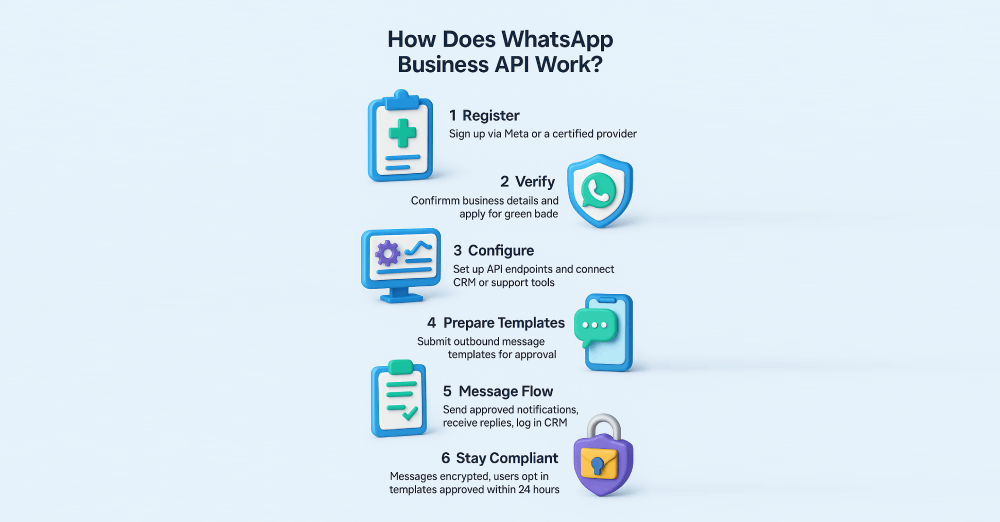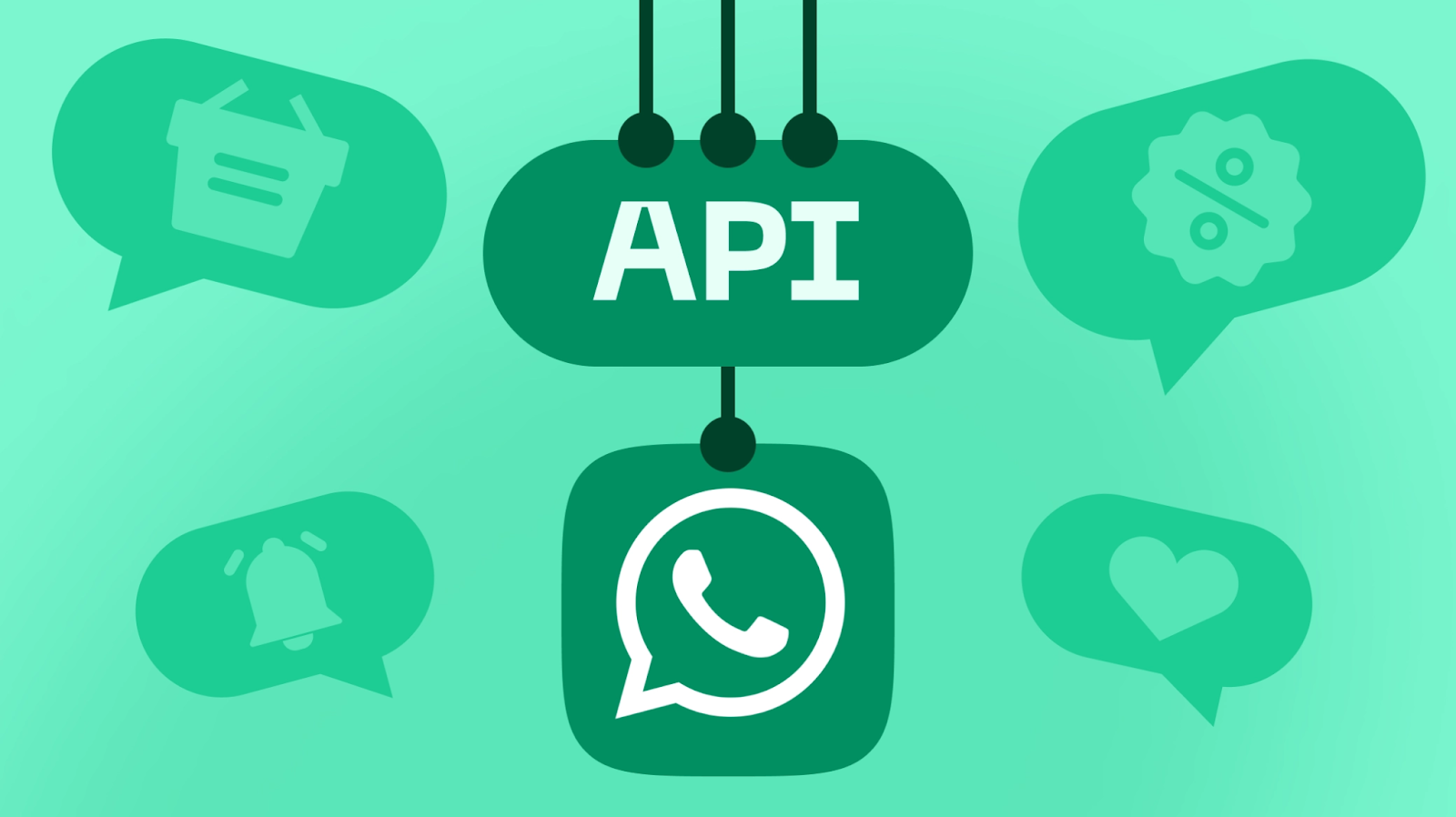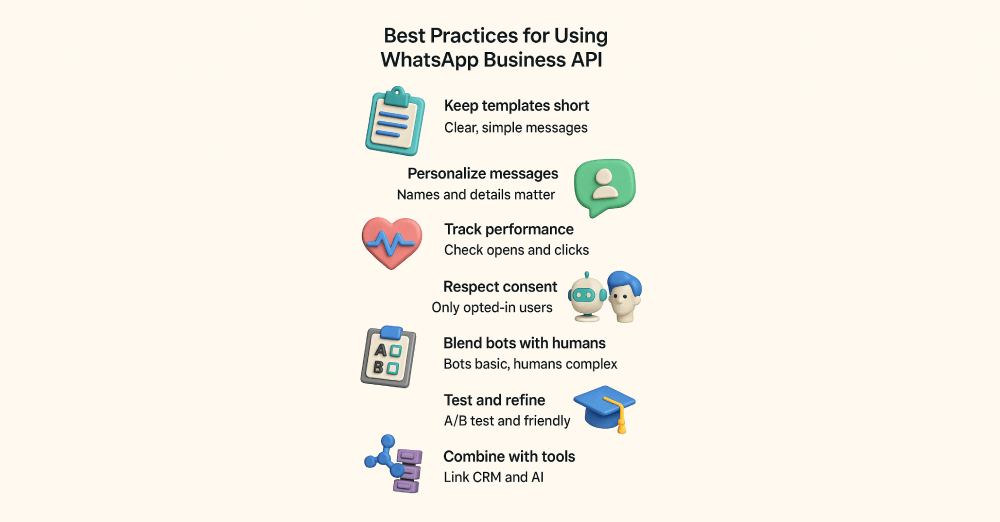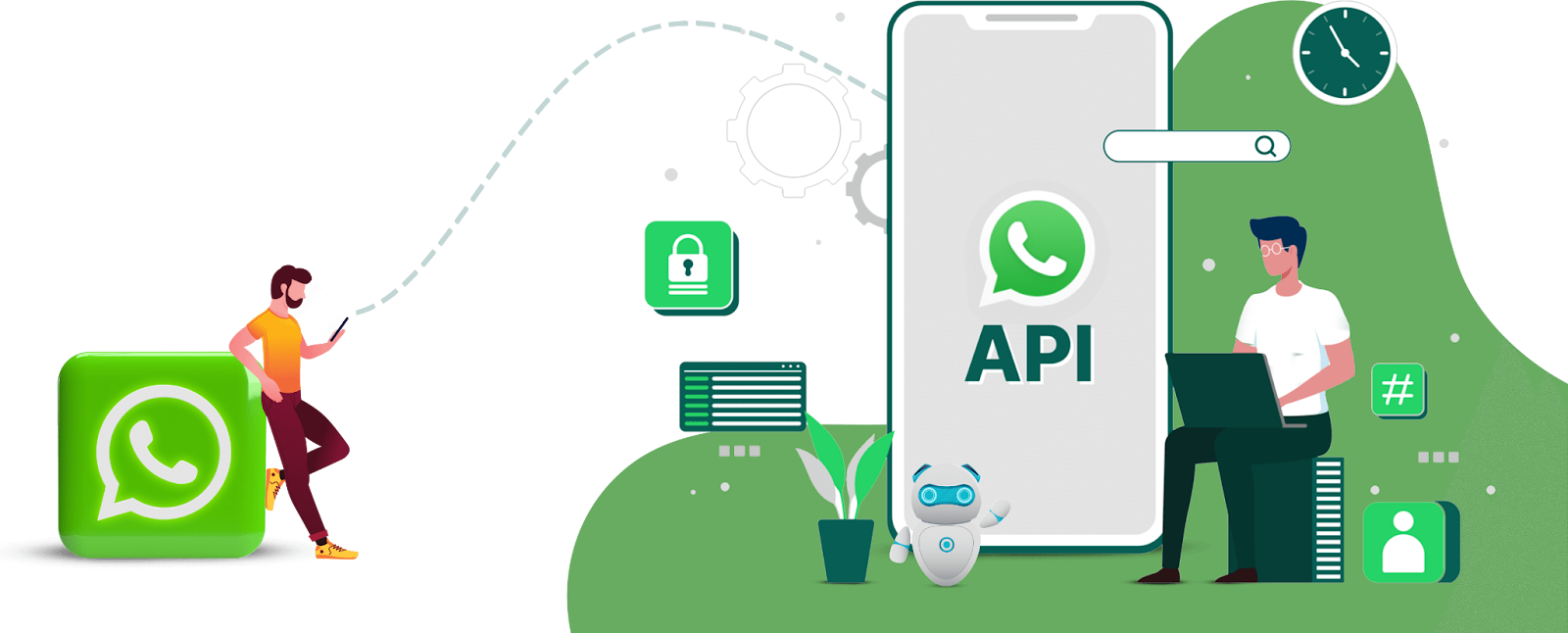In 2025 WhatsApp remains the world’s most used messaging app. It has grown to 2.93 billion monthly active users. Every day more than 530 million people contact businesses through WhatsApp. Open rates remain extremely high at about 98 % compared to only 20 % for email. Verified business accounts increased by 28 % in one year.
More than 5 million companies already use WhatsApp Business API. This is no longer a niche channel. It is a global infrastructure for customer communication. The API supports retail, banking, travel, healthcare, education, and even government services. This guide explains the API, its setup, features, benefits, use cases, and future trends.

What is WhatsApp Business API?
WhatsApp Business API is a scalable communication tool for medium and large companies. Unlike the free app for small shops, it supports automation, customer data integration, templates, and analytics source.
Businesses must pass verification via certified providers or Meta Cloud API. Only verified accounts can send official templates. Many apply for a green check badge to boost trust.
Since 2025 most of the API runs on cloud infrastructure. This lowers costs and makes adoption easier for smaller enterprises.
Key Features of WhatsApp Business API
Automated Messaging
Chatbots reply to frequent questions like orders or bookings. 70 % of users prefer instant responses. Automation also works outside office hours, keeping service always on.
Bulk Notifications
Companies send reminders, shipping updates, and alerts. In finance, 92 % of users feel safer with real-time fraud notifications. Templates keep outreach relevant and spam-free.
Rich Media Support
The API supports images, videos, QR codes, invoices, and PDFs. Airlines send boarding passes, clinics share test results, and retailers showcase products visually.
Two Way Conversations
Unlike SMS, WhatsApp supports dialogue. Customers reply in real time, reducing case resolution time by 30 % compared to email. Bots can escalate to agents when needed.
CRM Integration
The API syncs with Salesforce, HubSpot, and Zendesk. Every conversation is logged with history. Teams see past orders and issues, ensuring consistent and personalized replies.

How Does WhatsApp Business API Work?
Step 1. Registration
A company must first register with Meta or a certified WhatsApp Business Solution Provider. Registration ensures that only verified organizations gain access to the API.
Step 2. Verification
The business account must go through verification. This includes confirming company details and compliance with WhatsApp policies. Verified accounts can apply for a green badge that signals authenticity to customers.
Step 3. Configuration
Technical teams configure API endpoints for both inbound and outbound communication. These endpoints connect WhatsApp servers with the business’s systems. The setup can link to CRM, customer support platforms, or AI-driven bots.
Step 4. Template preparation
Outbound messages require pre-approved templates. These templates must be submitted to WhatsApp for review. Approval ensures that communication is clear, relevant, and non-promotional.
Step 5. Message flow
Once templates are approved, the business can send notifications such as order confirmations or reminders. Customers can reply directly. Incoming messages are routed through WhatsApp servers and logged into CRM or support software. This keeps a full history of interactions.
Step 6. Security and compliance
All messages pass through WhatsApp servers with end-to-end encryption. Users must opt in before receiving any business communication. This prevents spam and protects privacy. Businesses cannot send unsolicited offers or promotional spam. In 2025 the average approval time for new templates is under 24 hours, which allows quick launch of new campaigns.

Benefits of Using WhatsApp Business API
Engagement
WhatsApp has one of the highest engagement levels among digital channels. Open rates reach about 98 %, and click rates often fall between 45 % and 60 %. By comparison, email marketing averages around 20 % open rates. This difference makes WhatsApp one of the most reliable tools for urgent updates, reminders, and transactional messages. Companies in e-commerce and travel confirm that users are far more likely to read a WhatsApp message than an email.
Scalability
The API can handle thousands of conversations simultaneously without delays. Retailers during seasonal sales or banks during high-volume events such as tax deadlines rely on WhatsApp because it can manage peaks efficiently. This scalability is critical for enterprises that serve millions of customers across multiple time zones.
Cost reduction
Automation powered by templates and chatbots reduces the workload of human support teams. Businesses report saving up to 30 % in customer support costs. By filtering simple queries through automated flows, teams can focus on complex problems. This improves efficiency and reduces staff burnout.
Trust
Verified green badges confirm authenticity. Customers can see that the sender is an official business. Combined with end-to-end encryption, this creates strong security. In banking and healthcare, trust is essential, and WhatsApp provides both technical safety and visible reassurance.
Global coverage
The API currently supports over 40 languages, which makes it accessible worldwide. Global brands can localize messages and still manage everything from one integrated system.
Retention
Poor communication is one of the main reasons customers leave brands. Research shows that 64 % of customers switch providers after communication failures. WhatsApp reduces this risk by enabling real-time, reliable messaging. Retention improves because customers feel informed and respected.
Who Can Benefit from WhatsApp Business API?
E-commerce
Online stores confirm orders, share invoices, track shipping, and recover abandoned carts. In India, companies using WhatsApp recovered up to 60 % of abandoned sales. Brands also use rich media to showcase products, send discount codes, and handle returns more efficiently.
Healthcare
Hospitals use WhatsApp for appointment reminders, doctors send prescriptions, and clinics deliver lab results securely. A study shows 82 % of patients prefer scheduling by messages over phone calls. Telemedicine providers integrate WhatsApp for faster, lower-cost consultations.
Banking
Banks deliver balance alerts, fraud detection warnings, and account updates. In some markets, real-time alerts reduced reported fraud by 20 %. Financial institutions in Latin America use WhatsApp as a primary communication channel for account activity.
Travel and Hospitality
Hotels send booking confirmations, reminders, and promotions. Airlines share gate changes, cancellations, and flight delays. Passengers report higher satisfaction because updates are immediate. This reduces missed flights and unnecessary calls to hotlines.
Education and Public Services
Universities notify students about exam schedules or admission deadlines. Governments use WhatsApp for vaccination reminders, tax notices, or emergency alerts. In developing countries, WhatsApp is often the only effective digital channel to reach large parts of the population.
How to Get Started with WhatsApp Business API
Step 1. Choose a provider
Select a certified WhatsApp Business Solution Provider or Meta’s Cloud API. Providers offer different pricing and integration support.
Step 2. Verify your business
Submit documents for verification. This step ensures authenticity. Verified companies may also apply for a green badge, which increases user trust.
Step 3. Integrate with systems
Connect WhatsApp with CRM or customer support platforms. This enables data sharing and makes it easier to manage history and performance.
Step 4. Create and submit templates
Outbound messages must use templates. Templates should be concise, neutral, and value-focused. Submit them for approval before use.
Step 5. Test campaigns
Use sandbox environments to test flows, measure delivery speed, and identify errors before public launch.
Step 6. Launch gradually
Start with specific use cases such as order confirmations or support tickets. Expand step by step as teams gain experience.
Extend with AI and voice
Advanced businesses integrate WhatsApp with AI and voice tools. For example, the Graphlogic Generative AI & Conversational Platform builds intelligent chat flows that reduce human workload. The Graphlogic Text-to-Speech API turns text into natural voice, enabling updates via phone or voice assistants alongside WhatsApp. These integrations create seamless omnichannel experiences.

Best Practices for Using WhatsApp Business API
Keep templates short and clear
Message templates should be concise and easy to read. Long or complex texts reduce engagement. Customers prefer short reminders like “Your order is confirmed” or “Your appointment is tomorrow at 10 am.” Templates should follow natural conversation style. Use plain language, avoid jargon, and make sure every message communicates one clear action or update. Clear templates improve approval speed and reduce misunderstanding.
Personalize with names and context
Personalization improves trust and response rates. Add customer names, order details, or booking information. For example: “Hello Anna, your package #4823 is arriving today.” Research shows personalized notifications increase click-through rates by more than 20 %. Context also matters. If a user contacted support yesterday, reference the previous conversation. This shows continuity and reduces frustration.
Track performance metrics regularly
WhatsApp campaigns should be measured like any other channel. Monitor open rates, click rates, response times, and resolution times. Set benchmarks for each type of message. For example, shipping updates may reach 95 % open rate, while promotional offers may reach 60 %. Use analytics dashboards from providers or CRM integrations. Regular tracking helps identify weak templates and optimize future campaigns.
Respect user consent strictly
WhatsApp policies are strict. Users must opt in before receiving messages. Never send unsolicited promotions. Consent can be collected via website forms, checkout pages, or app notifications. Always give users an option to opt out easily. Violating consent rules risks account suspension. Respect for privacy also builds long-term loyalty. Customers are more likely to trust a brand that communicates transparently.
Blend automation with human escalation
Automation reduces workload, but human support remains essential. Chatbots handle FAQs or confirmations quickly, but complex issues need an agent. Design flows where a bot responds first and then transfers the conversation to a human if needed. Monitor handoff speed, since long delays harm trust. Businesses that balance automation with human touch keep efficiency high and preserve empathy in service.
Test and refine regularly
Run A/B tests with different templates. Compare tone, message length, and call-to-action buttons. Even small changes like “Track your package” versus “See delivery details” can improve engagement. Regular testing ensures the channel evolves with customer expectations.
Train teams and align tone
Staff using WhatsApp should follow consistent guidelines. The brand voice must remain friendly, clear, and professional. Training prevents errors like sending the wrong template or using informal tone in formal contexts. Alignment ensures customers receive a seamless experience across chat, email, and phone.
Combine with other tools
The API is most powerful when linked with CRM, analytics, or AI systems. For example, advanced platforms like the Graphlogic Generative AI & Conversational Platform can help design more natural replies. Voice extensions like the Graphlogic Text-to-Speech API allow delivering the same content across phone or voice assistants. Integration ensures WhatsApp is part of a broader omnichannel strategy.

Challenges of Implementing WhatsApp Business API
Setup costs and technical complexity
Implementing the API is not free. Businesses must pay providers for onboarding, configuration, and ongoing message fees. Integration with CRM or ERP often requires custom development. For small companies, these costs can be significant.
Compliance and template approval
WhatsApp requires pre-approved templates for outbound messages. This process ensures quality and prevents spam but can slow down campaigns. Businesses must adapt their communication style to strict rules. Templates that are too promotional often get rejected.
User expectations for speed
Customers expect almost instant replies. Research shows 46 % of users want a response in less than five minutes. Companies that fail to meet this standard risk frustration and negative reviews. Automation helps, but staff availability is also necessary.
Restrictions on unsolicited messages
Businesses cannot send random promotions. Communication must be opt-in and relevant. This limits flexibility for marketers who are used to broadcast channels like email.
Resource planning
To handle message flow, companies need trained teams and reliable automation. Without planning, the workload may overwhelm customer support. Poor execution damages reputation quickly.

Real-World Examples of WhatsApp Business API
Retail and e-commerce
Supermarkets and online retailers use WhatsApp to confirm orders, update delivery times, and manage returns. Customers appreciate real-time tracking and faster refunds.
Airlines and travel
Airlines share flight delays, boarding information, and digital boarding passes. This reduces stress for passengers and lowers call center traffic. Hotels use WhatsApp to confirm bookings and handle guest requests.
Banking and finance
Banks notify users of transactions, account balances, and fraud alerts. Real-time alerts build trust and prevent losses. Some financial institutions in Brazil now rely almost entirely on WhatsApp for customer communication.
Public services and healthcare
Governments distribute vaccination reminders and emergency alerts. Hospitals send appointment reminders and test results. Case studies show teams resolve issues 30 % faster with WhatsApp support compared to email or phone.
Global Adoption Trends
WhatsApp is a global platform, but businesses use it differently depending on local laws, culture, and digital habits. The table below shows how adoption looks in key regions.
| Region | Adoption Highlights |
| India | WhatsApp dominates with 500+ million users. Retail and fintech rely heavily on the API for payments, cart recovery, and customer support. |
| Brazil | Over 80 % of smartphone users use WhatsApp daily. Banks and fintech deeply integrate the API, making it the primary channel for account management. |
| Europe | GDPR defines usage. Businesses emphasize consent and clear opt-in. Healthcare and education sectors apply the API but must comply with strict privacy laws. |
| United States | Adoption grows in e-commerce, travel, and healthcare. Consumers prefer chat over calls. Integration with AI and CRM accelerates adoption in competitive markets. |
Each region adapts usage to local rules and customer behavior. This flexibility shows why WhatsApp Business API works globally.
The Future of WhatsApp Business API
WhatsApp is no longer just a messaging tool. In the next few years it will become a full business platform. From AI assistants to in-chat payments, the API is set to shape how companies talk, sell, and support worldwide.
AI-driven engagement
Over the next years, deeper AI integration will define WhatsApp. Bots will evolve from scripted responders into predictive assistants that anticipate user needs.
Widespread adoption
Analysts expect that 70 % of medium-sized businesses will adopt the API by 2027. Growth will be strong in emerging markets where WhatsApp dominates mobile usage.
Omnichannel integration
WhatsApp will not remain isolated. Businesses will connect it with email, voice, and video. Customers will move across channels while keeping context intact.
Competition from other platforms
WeChat, Telegram, and RCS may expand. However, WhatsApp’s global base remains the largest. Its scale makes it difficult for competitors to replace it.
Commerce inside chat
The API will expand from customer support to full commerce. Users will browse catalogs, place orders, and pay directly in chat. This will transform WhatsApp into a platform for both engagement and transactions.
Key Points to Remember
- WhatsApp Business API is designed for scale.
- It provides automation, templates, CRM integration, analytics.
- Engagement and trust outperform traditional channels.
- Businesses must prepare for compliance and cost challenges.
The future is AI, omnichannel, and commerce inside chat.
FAQ
It is an official interface that lets businesses communicate with customers securely and at scale.
The free app is manual for small companies. The API supports automation, templates, and CRM source.
Any verified business that works with an approved provider.
Meta introduced a per message model in July 2025. Pricing depends on region and volume source.
Yes via providers, but the free app is often easier for micro businesses.
Messages are fully end to end encrypted.
Retail, e-commerce, healthcare, banking, travel, education, and government.
Average approval time is under 24 hours in 2025.

